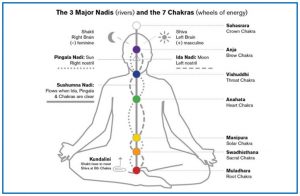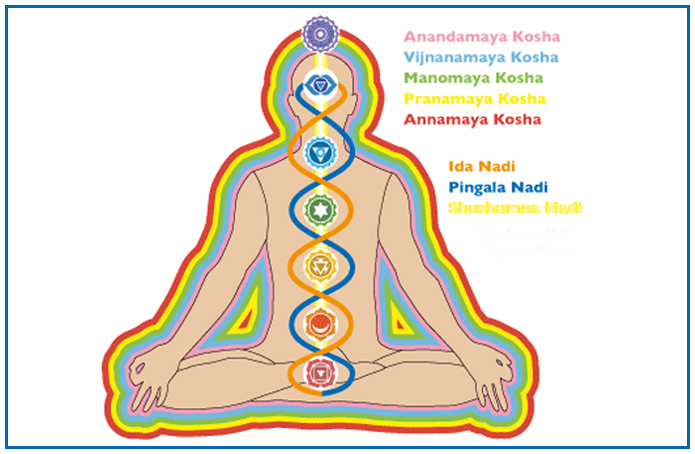We are alive because of some energy flow in the entire body, which is not visible. Visualize the rush of energy flow that one experiences when we are excited. Try to feel it, initially, it will be beyond understanding, but these energy flows can be felt when we focus it with concentration. Medical science elaborates in terms of nerve impulses, but the sages perceived it as energy flow and consciousness flowing through interconnected channels in our body called Nadis. They form an energy flow network. The term Nadi specifies ‘flow’. Thus nadis are responsible for energy flows, like electricity, radio waves and laser beams are delicate flows. Nadis specifies the energy flow in our body and should not be confused with nerves, which relate to the physical body. Nadis are pathways of pranic, mental and spiritual energy, which form a huge matrix throughout the physical body. Through Nadi, energy flows to every cell, and every organ through their huge network, carrying prana back and forth in every direction.
Nadis play an important role in the human body for energy flow. In yogic science, there is said to be 72864 nadis in our body. They take the message from the brain and this energy flows to the different parts of the body and vice a Versa. Out of these, there are 10 main nadis responsible for energy flows. Out of these 10, three are very important (Ida, Pingla and Sushumna)
Details of Ten Nadis
Ida Nadi- Its function is to activate breathing from the left nostril. It is also called Chandra Nadi. The energy flows on the left side of the body.
Pingala Nadi- Its function is to activate breathing through the right nostril. It is also called Surya Nadi. The energy flows on the right side of the body.
Sushumna Nadi– It is situated between the Ida and Pingala Nadi. According to Yogic science, its place is in the centre of the vertebral column, it is also called Brama Nadi. In the whole of the yogic science, Sushumna has been given the utmost importance therefore from a spiritual point of view also it is very important. It is through Sushumna only that dharna, Dhyan and ultimately Samadhi is achieved.
Gandhari Nadi- It is placed in the left eye and is responsible for the functioning of Sight through the left eye. This Nadi is responsible for energy flow in the left side.
Hast Jihwa Nadi– It is placed in the right eye and is responsible for the functioning of Sight through the right eye. This Nadi is responsible for energy flow on the right side.
Pusha Nari– It is placed in the right ear and is responsible for hearing from the right ear. This Nadi is responsible for energy flow on the right side.
Yashshivani Nadi it is placed in the left ear and is responsible for hearing from the left ear. This Nadi is responsible for energy flow in the left side.
Alambusha Nadi– it is situated in the tongue and experiences 6 juices these are sweet, sour, salty, spicy, bitter and astringent. This Nadi is responsible for energy flow in the entire tongue.
Kuhu Nadi– It is placed in the genital area. It helps in urine excretion. This Nadi is responsible for energy flow in the Swadhishthan Chakra.
Shankhini Nadi– It is placed on the anus and helps in stool excretion. This Nadi is responsible for energy flow in the Muladhara Chakra.
Nadis perform their separate functions as per the organ they are located in. When a devotee does Pranayama in a prescribed way, then all the nadis become free of impurities, as a result, the way for Sushumna Nadi opens up and then the life force reaches Brahma Randhara through this passage. Due to this passage, the devotee attains the highest level of consciousness.
However, we need to concentrate only on three main nadis- Ida, Pingala and Sushumna, as these three administer the whole system of the nadis and all the body processes.

In pranayama and prana vidya, one works chiefly with these three channels. These three paths are commonly known as Ganga (ida), Yamuna (pingala) and Saraswati (sushumna) after the three most important rivers in India, the last being an underground flow. The point where these three rivers meet is called Prayag. In our pranic body also, they converge at Ajna (agya) chakra.
However, this pathway remains dormant in most people until a higher state of evolution or consciousness is reached.
The place of origin of ida and pingala is muladhara Chakra. It is through this chakra the pingala nadi makes a semicircular curved towards the right side of the spine and proceed upward and meets at the swadhisthana Chakra situated in this spine. Thereafter the pingla nadi again proceeds forward from the left of the spine in a semi-circular way and reaches the Manipura Chakra situated in the spine. Similarly, the pingala Nadi cuts spine and proceeds forward on the semicircular way through the anahat & vishuddhi Chakra, in the end it reaches the agya Chakra situated at the centre of the head and at the topmost part of the spine. Even the ida nadi follows the pingla nadi and moves forward in the opposite direction.
Between Ida and pingala is sushumna Nadi through which they mutually cross each other and move. The path of Sushumna nadi is mysterious, it is the minute Nadi which makes the flow of yoga Shakti. Sushumna nadi proceeds in the centre of the spine meeting the ida and the pingla at the place of Chakras Sushumna Nadi starts from the muladhara Chakra and it crosses the various Chakras and finally reaches the sahasrara Chakra the awakening of Kundalini Shakti takes place in the sushumna nadi, as the Kundalini Shakti proceeds by the way of Sushumna at the same time the part of the enlightenment keeps opening.
The flow of ida nadi is in the left nostril along with the breath and pingla nadis flow in the right nostril, both these breath flows have relations with the sympathetic and parasympathetic nervous system which controls the various activities of the body regulate them and keeps them balanced mutually in most of the organs of the body. There is a supply of sympathetic and parasympathetic nerves they worked opposite to each other sympathetic nerve accelerate the working of organs and parasympathetic nerves suppress them. In this way, due to the result of two mutually opposite influences organs remains in the middle situation of being overactive or underactive.
When the sympathetic nerve is more active than the activities of the body increase from the outside similarly then the parasympathetic nerve is more active than the activities of the body increase from the inside. Ida Nadi regulates the flow of the parasympathetic nerve whereas pingala Nadi regulates the sympathetic nerve.
The influence of the sympathetic nervous system is more at times when breathing takes place rapidly from the right nostril. In contrary to this when the parasympathetic nerve is more active in relation then the flow of breath from the left nostril takes place.
Pingla is associated with various physical activities of the body and ida is associated with various types of thoughts and emotions that time when either a thought or an action will have more effect on a person’s life will depend on flow of breath from right or left nostril in the same way the effect and working of sympathetic and parasympathetic nervous system will also depend upon the flow of ida and Pingala.
Normally the flow of pingala Nadi is more dominant during the daytime and ida nadi during the night. If a person is more worried about his work and he works more than his physical capacity then day and night his pingala Nadi remains dominant.
If this continues for too long then an imbalance in the physical and mental being will be created in a person who makes him ill. In the modern competitive world, this is the state of most people this situation is the major cause for the occurrence of many diseases like cancer etc.
On the other hand, a person who thinks a lot remains engrossed in his own problems works less and has less interest in the attractions of the outer world his ida nadi is more dominant. In the absence of physical labour, such a person suffers from many physical and mental diseases like neurosis etc.
Thus, it is very necessary to have a balance in the flow of Ida and Pingala nadi
“Practice Pranayama and Meditation for the Proper Energy flow and Balancing the Whole Body”

























